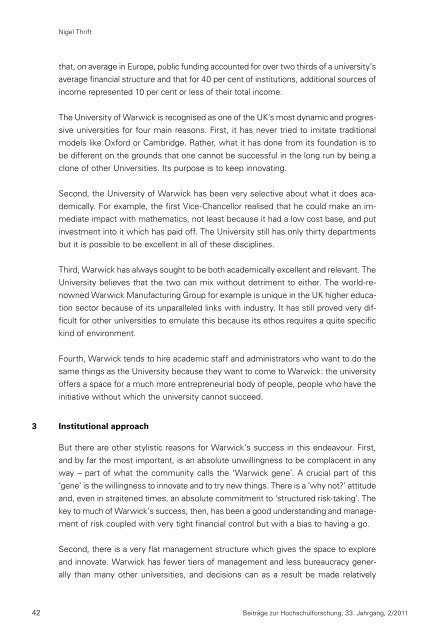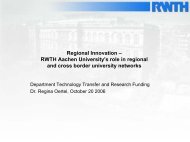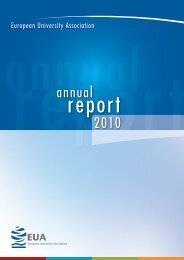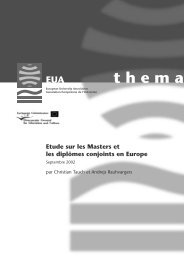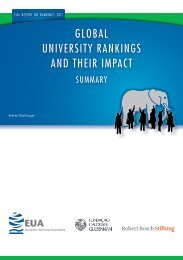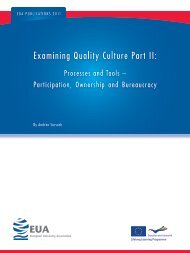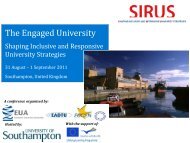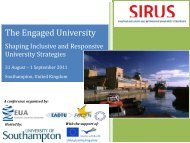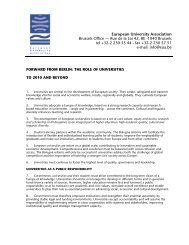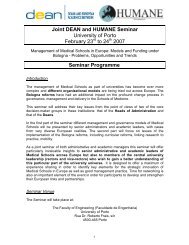Beiträge zur Hochschulforschung - European University Association
Beiträge zur Hochschulforschung - European University Association
Beiträge zur Hochschulforschung - European University Association
You also want an ePaper? Increase the reach of your titles
YUMPU automatically turns print PDFs into web optimized ePapers that Google loves.
42<br />
Nigel Thrift<br />
that, on average in Europe, public funding accounted for over two thirds of a university’s<br />
average financial structure and that for 40 per cent of institutions, additional sources of<br />
income represented 10 per cent or less of their total income.<br />
The <strong>University</strong> of Warwick is recognised as one of the UK’s most dynamic and progres-<br />
sive universities for four main reasons. First, it has never tried to imitate traditional<br />
models like Oxford or Cambridge. Rather, what it has done from its foundation is to<br />
be different on the grounds that one cannot be successful in the long run by being a<br />
clone of other Universities. Its purpose is to keep innovating.<br />
Second, the <strong>University</strong> of Warwick has been very selective about what it does aca-<br />
demically. For example, the first Vice-Chancellor realised that he could make an im-<br />
mediate impact with mathematics, not least because it had a low cost base, and put<br />
investment into it which has paid off. The <strong>University</strong> still has only thirty departments<br />
but it is possible to be excellent in all of these disciplines.<br />
Third, Warwick has always sought to be both academically excellent and relevant. The<br />
<strong>University</strong> believes that the two can mix without detriment to either. The world-re-<br />
nowned Warwick Manufacturing Group for example is unique in the UK higher educa-<br />
tion sector because of its unparalleled links with industry. It has still proved very dif-<br />
ficult for other universities to emulate this because its ethos requires a quite specific<br />
kind of environment.<br />
Fourth, Warwick tends to hire academic staff and administrators who want to do the<br />
same things as the <strong>University</strong> because they want to come to Warwick: the university<br />
offers a space for a much more entrepreneurial body of people, people who have the<br />
initiative without which the university cannot succeed.<br />
3 Institutional approach<br />
But there are other stylistic reasons for Warwick’s success in this endeavour. First,<br />
and by far the most important, is an absolute unwillingness to be complacent in any<br />
way – part of what the community calls the ‘Warwick gene’. A crucial part of this<br />
‘gene’ is the willingness to innovate and to try new things. There is a ‘why not?’ attitude<br />
and, even in straitened times, an absolute commitment to ‘structured risk-taking’. The<br />
key to much of Warwick’s success, then, has been a good understanding and manage-<br />
ment of risk coupled with very tight financial control but with a bias to having a go.<br />
Second, there is a very flat management structure which gives the space to explore<br />
and innovate. Warwick has fewer tiers of management and less bureaucracy gener-<br />
ally than many other universities, and decisions can as a result be made relatively<br />
<strong>Beiträge</strong> <strong>zur</strong> <strong>Hochschulforschung</strong>, 33. Jahrgang, 2/2011


